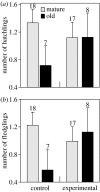Senescent birds redouble reproductive effort when ill: confirmation of the terminal investment hypothesis
- PMID: 16777735
- PMCID: PMC1560321
- DOI: 10.1098/rspb.2006.3480
Senescent birds redouble reproductive effort when ill: confirmation of the terminal investment hypothesis
Abstract
This study reports an experimental confirmation of the terminal investment hypothesis, a longstanding theoretical idea that animals should increase their reproductive effort as they age and their prospects for survival and reproduction decline. Previous correlational and experimental attempts to test this hypothesis have yielded contradictory results. In the blue-footed booby, Sula nebouxii, a long-lived bird, after initial increase, male reproductive success declines progressively with age. Before laying, males of two age classes were challenged with lipopolysaccharide to elicit an immune response, which induced symptoms of declining survival prospects. Reproductive success of immune-challenged mature males fell, while that of immune-challenged old males showed a 98% increase. These results demonstrate that senescent males with poor reproductive prospects increase their effort when those prospects are threatened, whereas younger males with good reproductive prospects do not.
Figures


Similar articles
-
Male reproductive senescence: the price of immune-induced oxidative damage on sexual attractiveness in the blue-footed booby.J Anim Ecol. 2007 Nov;76(6):1161-8. doi: 10.1111/j.1365-2656.2007.01282.x. J Anim Ecol. 2007. PMID: 17922712
-
Pigment-based skin colour in the blue-footed booby: an honest signal of current condition used by females to adjust reproductive investment.Oecologia. 2006 Sep;149(3):535-42. doi: 10.1007/s00442-006-0457-5. Epub 2006 Jul 4. Oecologia. 2006. PMID: 16821015
-
Enhanced male coloration after immune challenge increases reproductive potential.J Evol Biol. 2014 Aug;27(8):1582-9. doi: 10.1111/jeb.12416. Epub 2014 May 20. J Evol Biol. 2014. PMID: 24846565
-
Orchestration of avian reproductive effort: an integration of the ultimate and proximate bases for flexibility in clutch size, incubation behaviour, and yolk androgen deposition.Biol Rev Camb Philos Soc. 2006 Nov;81(4):629-66. doi: 10.1017/S1464793106007147. Epub 2006 Oct 12. Biol Rev Camb Philos Soc. 2006. PMID: 17038202 Review.
-
Reproductive costs in terrestrial male vertebrates: insights from bird studies.Proc Biol Sci. 2016 Jan 27;283(1823):20152600. doi: 10.1098/rspb.2015.2600. Proc Biol Sci. 2016. PMID: 26791619 Free PMC article. Review.
Cited by
-
Terminal investment and senescence in rhesus macaques (Macaca mulatta) on Cayo Santiago.Behav Ecol. 2010 Sep;21(5):972-978. doi: 10.1093/beheco/arq098. Epub 2010 Jun 29. Behav Ecol. 2010. PMID: 22475990 Free PMC article.
-
Contrasting life histories in neighbouring populations of a large mammal.PLoS One. 2011;6(11):e28002. doi: 10.1371/journal.pone.0028002. Epub 2011 Nov 18. PLoS One. 2011. PMID: 22125651 Free PMC article.
-
The suppression of a selfish genetic element increases a male's mating success in a fly.Ecol Evol. 2023 Nov 12;13(11):e10719. doi: 10.1002/ece3.10719. eCollection 2023 Nov. Ecol Evol. 2023. PMID: 37964789 Free PMC article.
-
Sex and the cost of reproduction through the life course of an extremely long-lived herb.Oecologia. 2019 Oct;191(2):369-375. doi: 10.1007/s00442-019-04491-0. Epub 2019 Aug 19. Oecologia. 2019. PMID: 31428868
-
Interactions between reproductive biology and microbiomes in wild animal species.Anim Microbiome. 2021 Dec 23;3(1):87. doi: 10.1186/s42523-021-00156-7. Anim Microbiome. 2021. PMID: 34949226 Free PMC article. Review.
References
-
- Bennett P.M, Owens I.P.F. Oxford University Press; Oxford, UK: 2002. Evolutionary ecology of birds.
-
- Bonneaud C, Mazuc J, Gonzalez G, Haussy C, Chastel O, Faivre B, Sorci G. Assessing the cost of mounting an immune response. Am. Nat. 2003;161:367–379. doi:10.1086/346134 - DOI - PubMed
-
- Bonneaud C, Mazuc J, Chastel O, Westerdahl H, Sorci G. Terminal investment induced by immune challenge and fitness traits associated with major histocompatibility complex in the house sparrow. Evolution. 2004;58:2823–2830. - PubMed
-
- Brooks R, Kemp D.J. Can older males deliver the good genes? Trends Ecol. Evol. 2001;16:308–313. doi:10.1016/S0169-5347(01)02147-4 - DOI - PubMed
-
- Charlesworth B. Cambridge University Press; Cambridge, UK: 1994. Evolution in age-structured populations.
Publication types
MeSH terms
Substances
LinkOut - more resources
Full Text Sources
Other Literature Sources

